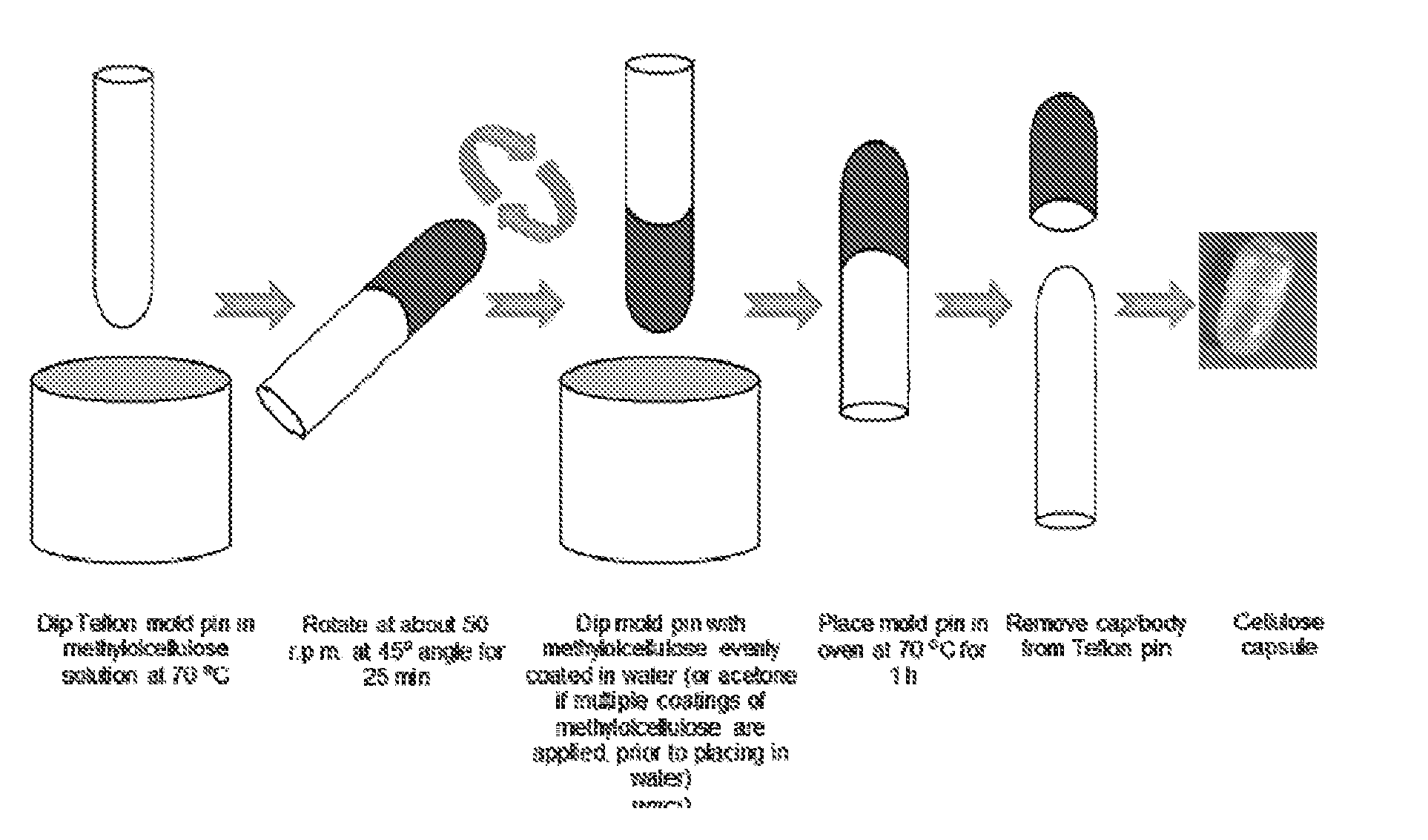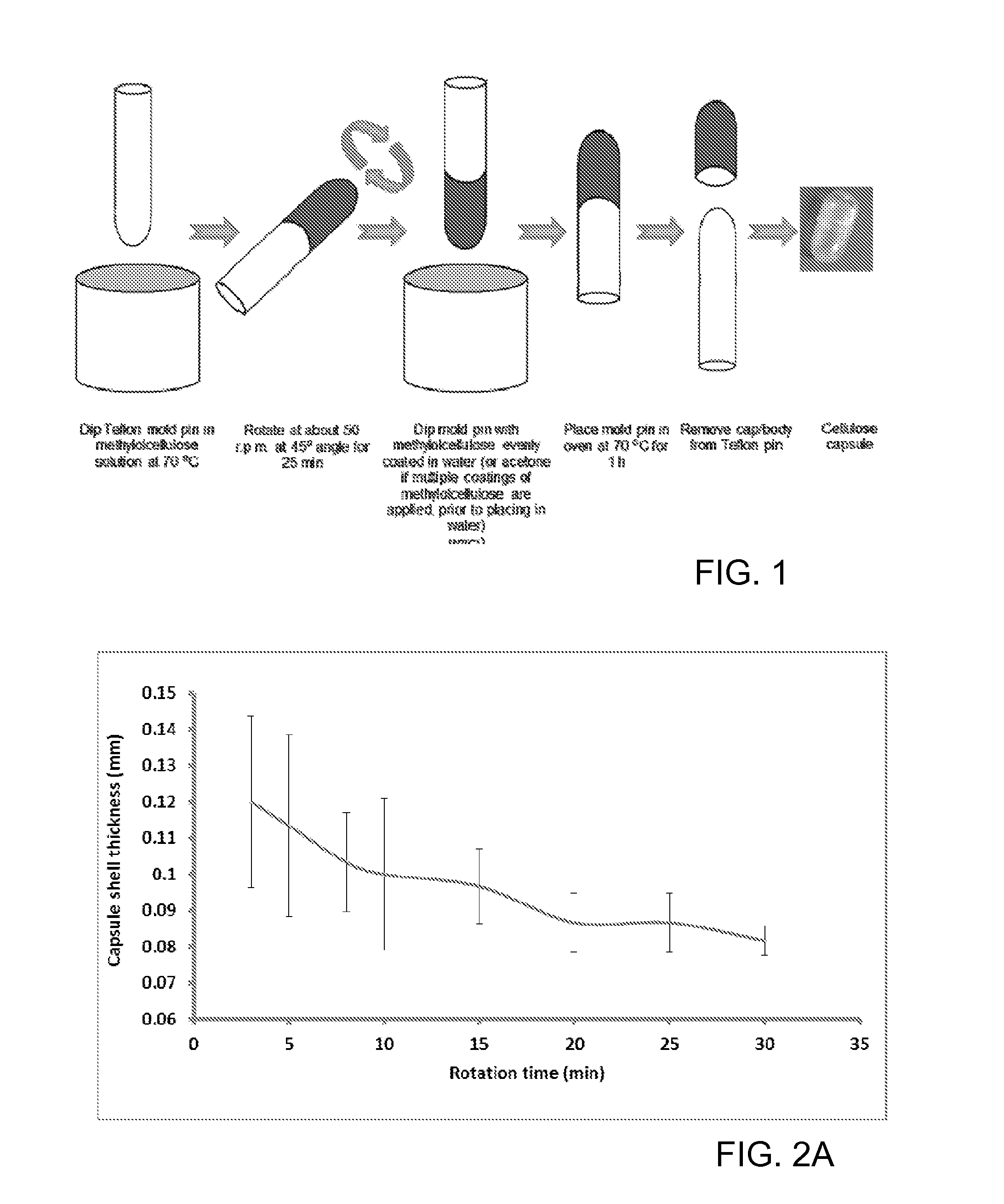Cellulose capsules and methods for making them
a technology of cellulose capsules and cellulose, applied in the field of cellulose capsules and methods for making them, can solve the problems of affecting the usability of the product, erratic dissolution profiles, and unsuitability of gelatin capsules for certain drugs
- Summary
- Abstract
- Description
- Claims
- Application Information
AI Technical Summary
Benefits of technology
Problems solved by technology
Method used
Image
Examples
example 1
Preparation of Methylolcellulose Solution
[0089]General schemes for preparing cellulose solutions are known to those of skill in the art. The following method describes non-limiting method conditions for generating a methylolcellulose solution from cotton linter starting material. Briefly, cellulose (cotton linter) can be converted into a methylolcellulose solution by reacting cotton linter with paraformaldehyde in anhydrous dimethylsulfoxide at 120-140° C. for 4-6 h. In a typical experiment, pieces of cotton linters (50 g, cut to about 1 cm×1 cm) were dried in an oven at 70-80° C. for 24 h. In a three-neck 1000 mL round bottom flask, equipped with a condenser and a thermometer, about 500 mL of DMSO was added and heated to 105° C. for 4 h. The oven-dried cotton linters (about 24 g) were then added to the DMSO and allowed to soak for about 2 h at 105° C. The temperature was then raised to 125° C. and 60 g of paraformaldehyde was then added in portions. The heating at 125° C. was conti...
example 2
Preparation of Cellulose-Containing Capsule Shells
[0090]Methylolcellulose solutions containing 2.2, 3.3 and 4.4% w / w cellulose contents, on a dry weight basis, were prepared from cotton linter by treatment with paraformaldehyde in dimethylsulfoxide according to Example 1. Capsule shells were fabricated by dipping the Teflon pins of dimensions 8.0 mm×10 cm (capsule body) and 8.3 mm×10 cm (capsule cap) in the methylolcellulose solution for about 30 sec, and subsequently rotating the pins at a 45° angle at 50±5 r.p.m. for 5 to 45 min in air. The coated pin was placed in acetone (20.0 mL) for about 10 min and then air dried. The dipping and rotating steps were repeated 2-7 times. The coated Teflon pins were then immersed in deionized water (1.5 L) for about 24 h. The capsule shells were then cut to the desired length and cured at 70° C. for 1 h. After curing, the shells were removed from the pins, and stored in a dry container. See, FIG. 1. With one coating, the capsule shell thickness ...
example 3
Release Properties of Cellulose Capsule Shells
[0092]Cellulose capsule shells of three different shell thicknesses (0.05, 0.06 and 0.07 mm) were prepared from the methylolcellulose solution (cellulose content 4.4%, w / w) according to Example 2. They were filled with a homogeneously mixed powder blend of acetaminophen (50 mg) and lactose (150 mg). The dissolution study was performed in water (900 mL) at 37±0.5° C. and 100±2 r.p.m. using a Hansen Research USP II basket apparatus (Hansen Research Corp., Chatsworth, Calif.). The amount of drug released was determined by high performance liquid chromatography (HPLC) using an absolute calibration method and a fully automated Shimadzu LC-6A high performance liquid chromatograph, equipped with a C18 analytical column (Supelco—Sigma Aldrich, Bellefonte, Pa.). The drug was eluted with a 1:3 methanol:water mixture at a flow rate of 0.5 mL / min and detected at a wavelength of 243 nm. The release of acetaminophen increased linearly with time (see F...
PUM
| Property | Measurement | Unit |
|---|---|---|
| degree of crystallinity | aaaaa | aaaaa |
| thickness | aaaaa | aaaaa |
| thickness | aaaaa | aaaaa |
Abstract
Description
Claims
Application Information
 Login to View More
Login to View More - R&D
- Intellectual Property
- Life Sciences
- Materials
- Tech Scout
- Unparalleled Data Quality
- Higher Quality Content
- 60% Fewer Hallucinations
Browse by: Latest US Patents, China's latest patents, Technical Efficacy Thesaurus, Application Domain, Technology Topic, Popular Technical Reports.
© 2025 PatSnap. All rights reserved.Legal|Privacy policy|Modern Slavery Act Transparency Statement|Sitemap|About US| Contact US: help@patsnap.com



